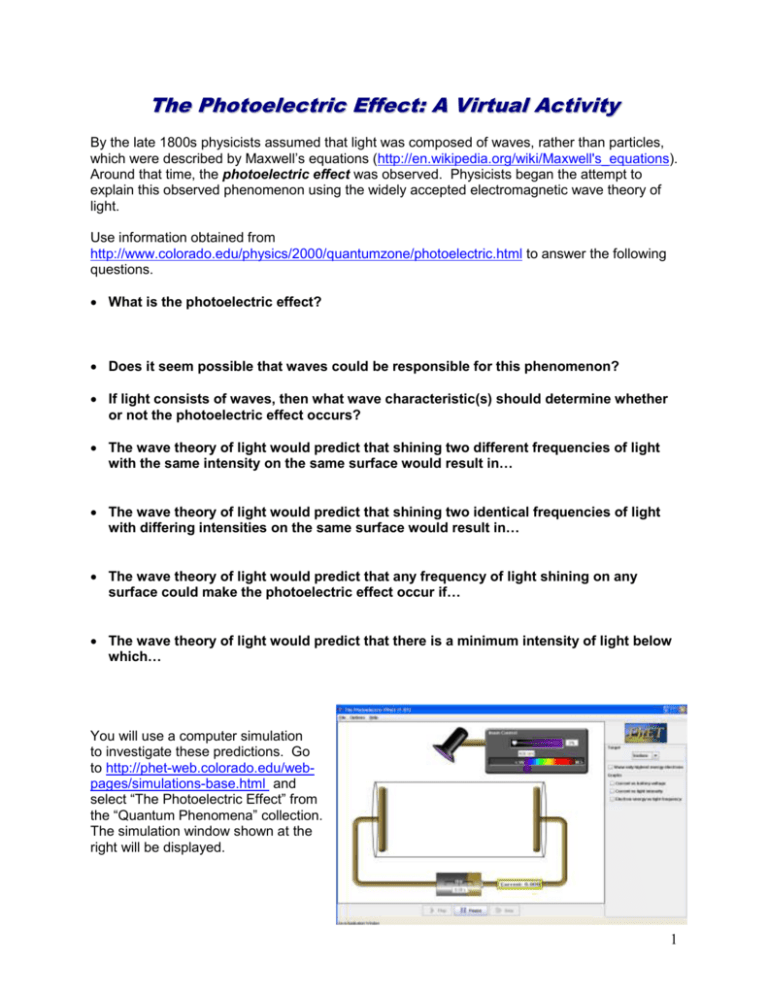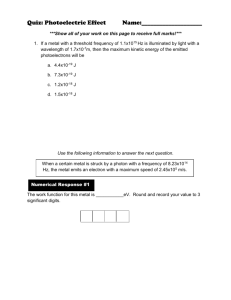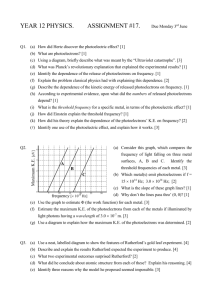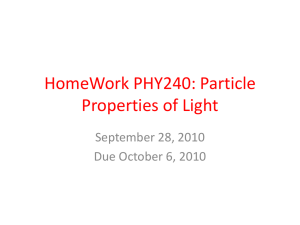The Photoelectric Effect
advertisement

The Photoelectric Effect: A Virtual Activity By the late 1800s physicists assumed that light was composed of waves, rather than particles, which were described by Maxwell’s equations (http://en.wikipedia.org/wiki/Maxwell's_equations). Around that time, the photoelectric effect was observed. Physicists began the attempt to explain this observed phenomenon using the widely accepted electromagnetic wave theory of light. Use information obtained from http://www.colorado.edu/physics/2000/quantumzone/photoelectric.html to answer the following questions. What is the photoelectric effect? Does it seem possible that waves could be responsible for this phenomenon? If light consists of waves, then what wave characteristic(s) should determine whether or not the photoelectric effect occurs? The wave theory of light would predict that shining two different frequencies of light with the same intensity on the same surface would result in… The wave theory of light would predict that shining two identical frequencies of light with differing intensities on the same surface would result in… The wave theory of light would predict that any frequency of light shining on any surface could make the photoelectric effect occur if… The wave theory of light would predict that there is a minimum intensity of light below which… You will use a computer simulation to investigate these predictions. Go to http://phet-web.colorado.edu/webpages/simulations-base.html and select “The Photoelectric Effect” from the “Quantum Phenomena” collection. The simulation window shown at the right will be displayed. 1 Part 1: Cutoff Frequency In the early 1900s, Albert Einstein predicted, and R.A. Millikin experimentally confirmed, that whether or not the photoelectric effect occurs depends on the incident frequency (wavelength) of radiation (i.e., light) and the type of metal surface, regardless of the intensity of the radiation (light). This is in sharp contrast to the wave theory of light’s prediction that photoelectrons should be emitted by light of any frequency as long as its intensity is great enough. Procedure: For each target metal (sodium, zinc, copper, platinum, calcium, unknown), determine the maximum wavelength (minimum frequency) necessary for photoelectrons to be emitted. Use v = fλ (velocity = frequency x wavelength) and the speed of light in a vacuum to calculate the frequencies. Surface Maximum Wavelength, nm Maximum Wavelength, m Minimum Frequency, Hz (aka “cutoff frequency”) Sodium Zinc Copper Platinum Calcium Unknown Part 2: Work Function Now that you have determined the maximum wavelength (minimum frequency) necessary for photoelectrons to be emitted, you will investigate the kinetic energy of the photoelectrons in relation to the frequency of incident radiation. According to the wave theory of light, increasing the intensity of the incident radiation should make the photoelectrons leaving the surface of the target metal have more kinetic energy. In this part you will investigate the kinetic energy of the photoelectrons as they are emitted from a target metal after a single frequency of radiation with differing intensities shines upon it. The more kinetic energy the photoelectrons have, the more difficult it will be for a negatively charged plate to repel them. Procedure: Complete each table by first selecting the specified target metal and any wavelength of radiation that will cause photoelectrons to be emitted. Then find the maximum stopping potential (voltage) for which all photoelectrons are repelled by the collector plate (indicated by a current reading of 0). The greater this stopping potential (voltage), the greater the kinetic energy of the photoelectrons. The wave theory of light predicts that the greater the intensity of the incident radiation, the more kinetic energy the photoelectrons will have, which will make the necessary stopping potential more negative. 2 I. Target Metal: ___Sodium____ Wavelength: _____________ Frequency: _____________ Beam Intensity, % 10 20 30 40 50 60 70 80 90 100 Stopping Potential, V II. Target Metal: _____Zinc____ Wavelength: _____________ Frequency: _____________ Beam Intensity, % 10 20 30 40 50 60 70 80 90 100 Stopping Potential, V III. Target Metal: ___Copper____ Wavelength: _____________ Frequency: _____________ Beam Intensity, % 10 20 30 40 50 60 70 80 90 100 Stopping Potential, V IV. Target Metal: ___Platinum___ Wavelength: _____________ Frequency: _____________ Beam Intensity, % 10 20 30 40 50 60 70 80 90 100 Stopping Potential, V V. Target Metal: ___Calcium___ Wavelength: _____________ Frequency: _____________ Beam Intensity, % 10 20 30 40 50 60 70 80 90 100 Stopping Potential, V VI. Target Metal: __Unknown___ Wavelength: _____________ Frequency: _____________ Beam Intensity, % 10 20 30 40 50 60 70 80 90 100 Stopping Potential, V According to your data, how, if at all, did the kinetic energy of the photoelectrons depend on the intensity of the incident radiation? What did noticeably change as you varied the intensity in the incident radiation? Part 3: Determining Planck’s Constant In this part you will determine how the energy of the photoelectrons depends on the wavelength (or frequency) of the incident radiation. Procedure: For each table, choose the specified target metal and find the stopping potential for 9 different wavelengths that cause photoelectrons to be emitted. 3 I. Target Metal: Sodium Wavelength, nm Wavelength, m Frequency, Hz Stopping Potential, -V Wavelength, m Frequency, Hz Stopping Potential, -V III. Target Metal: Copper Wavelength, nm Wavelength, m Frequency, Hz Stopping Potential, -V Insert graph here. II. Target Metal: Zinc Wavelength, nm Insert graph here. Insert graph here. 4 IV. Target Metal: Platinum Wavelength, nm Wavelength, m Frequency, Hz Stopping Potential, -V Frequency, Hz Stopping Potential, -V Frequency, Hz Stopping Potential, -V Insert graph here. V. Target Metal: Calcium Wavelength, nm Wavelength, m Insert graph here. VI. Target Metal: Unknown Wavelength, nm Wavelength, m Insert graph here. 5 Use Microsoft Excel to make a plot of “Stopping Potential vs Frequency” for each of the previous trials. Record the equation for each curve. Copy and paste each plot below its data table. The slope of each line should be equal to Planck’s constant, with units of eV•s. The y-intercept will be equal to –W, where W = the work function in eV. Compare your experimental value of the work function with its accepted value. Use your graphs and equations to complete the table below. Compare your experimental value of Planck’s constant with its accepted value. Target Metal Sodium Zinc Copper Platinum Calcium Unknown Experimental Work Function, eV 4.05 Accepted Work Function, eV 2.28 4.3 4.7 6.35 2.9 % Error Experimental Planck’s Constant, eV•s Accepted Planck’s Constant, eV•s % Error 4.136 x 10-15 4.136 x 10-15 4.136 x 10-15 4.136 x 10-15 4.136 x 10-15 4.136 x 10-15 Determine what the unknown material is. Describe how you found out below. 6










